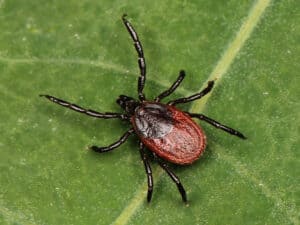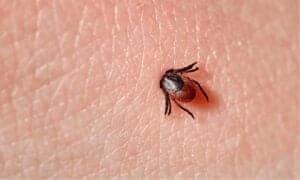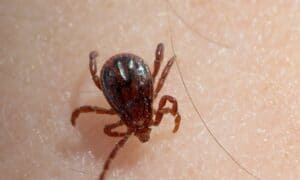Ticks in Illinois
@media (min-width: 481px) {
.mobile-top-content {
display: none;
}
}
#mobileTopContentCTACarouselControls { overflow: hidden; text-overflow: ellipsis; white-space: nowrap; }
.mobile-top-content .more { color: #fff; }
.mobile-top-content a { color: #fff; text-decoration: underline; }
.mobile-top-content a:hover { color: #fff; text-decoration: underline; }
@media (max-width: 480px) {
.mobile-top-content {
background-color: #06a10b;
color: #fff;
text-align: center;
/*height: 60px;
padding-top:5px;*/
font-size:80%;
/* display: block; */
margin: 0px -30px;
}
}
Out of all the tiny creatures that bite us, ticks just may be one of the most reviled. Though they’re not in the same class as mosquitos (mosquitos are insects, whereas ticks are arachnids), tick bites can still turn deadly. There are four common species of ticks in Illinois, but only one of them spreads Lyme disease to humans.
Ticks have been around for over 100 million years, since the Cretaceous era. In all that time, their diet has never changed. Ticks are obligate hematophages, which means they eat nothing but blood. With that blood, they grow, reproduce, and find new hosts.
Here, we’ll learn about the four most common types of ticks in Illinois. Then, we’ll explore when ticks come out in Illinois, where they’re most common, and whether or not they spread Lyme disease. Finally, we’ll go over the steps you can take to avoid tick bites.
Deer Tick (Ixodes scapularis)
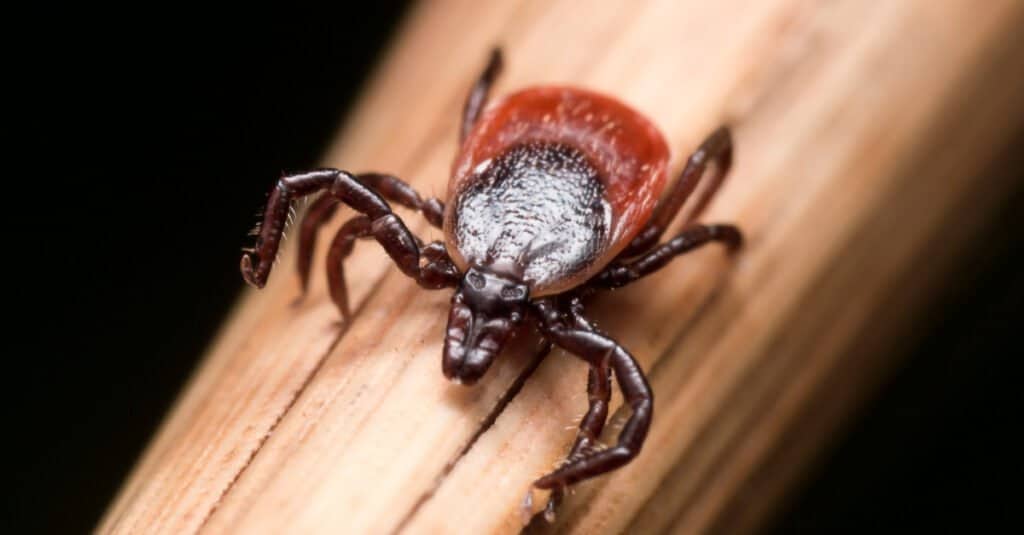
Steven Ellingson/Shutterstock.com
Deer ticks live throughout the midwestern and eastern United States and Canada. They start life in the early spring when the eggs hatch and larval ticks emerge. The larval ticks take their first feeding on something small, like a mouse, lizard, or bird. After their first feed, they fall off the host and grow into nymphs. The nymphs feed on another host, then fall off and become adults.
Adult deer ticks are commonly to blame for bites on humans, though white-tailed deer are their preferred prey. Deer ticks live in second-growth forests and boundary zones between forests and grasslands.
Lone Star Tick (Amblyomma americanum)
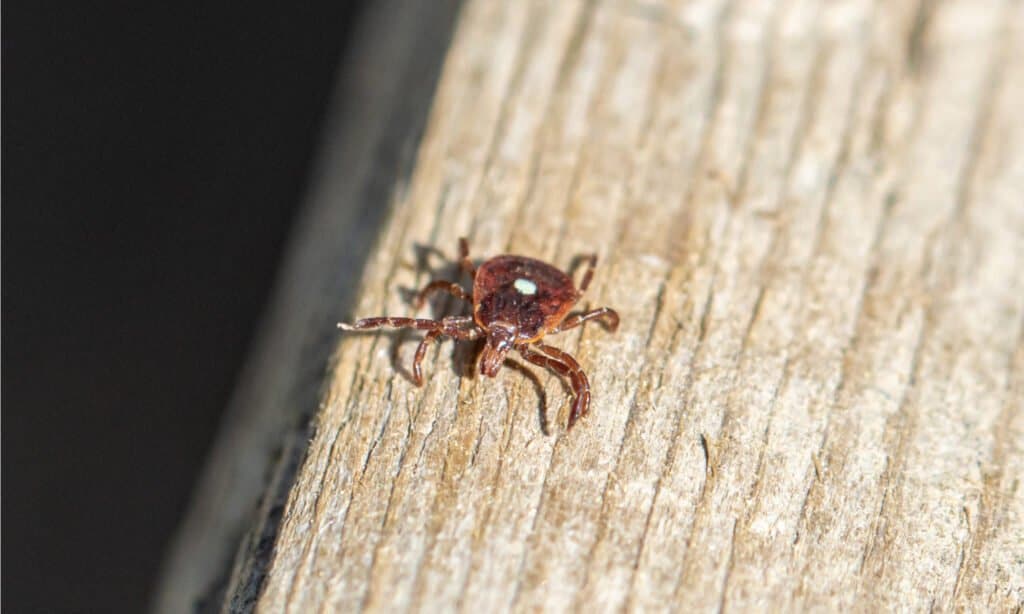
Maria T Hoffman/Shutterstock.com
Lone star ticks live throughout the eastern United States; they’re one of the more common ticks in Illinois. Females have a single white spot on their back, while males have mottled streaks of white and light brown. They will feed on any available host, including humans and dogs, though they prefer white-tailed deer. These ticks live primarily in wooded areas and thick underbrush.
Lone star ticks were the first tick ever scientifically recorded in America in 1754. They’re aggressive feeders and will even follow carbon dioxide scents in search of prey. These ticks have longer mouthparts than other species of ticks in Illinois, making their bites more likely to cause allergic reactions.
Brown Dog Tick (Rhipicephalus sanguineus)
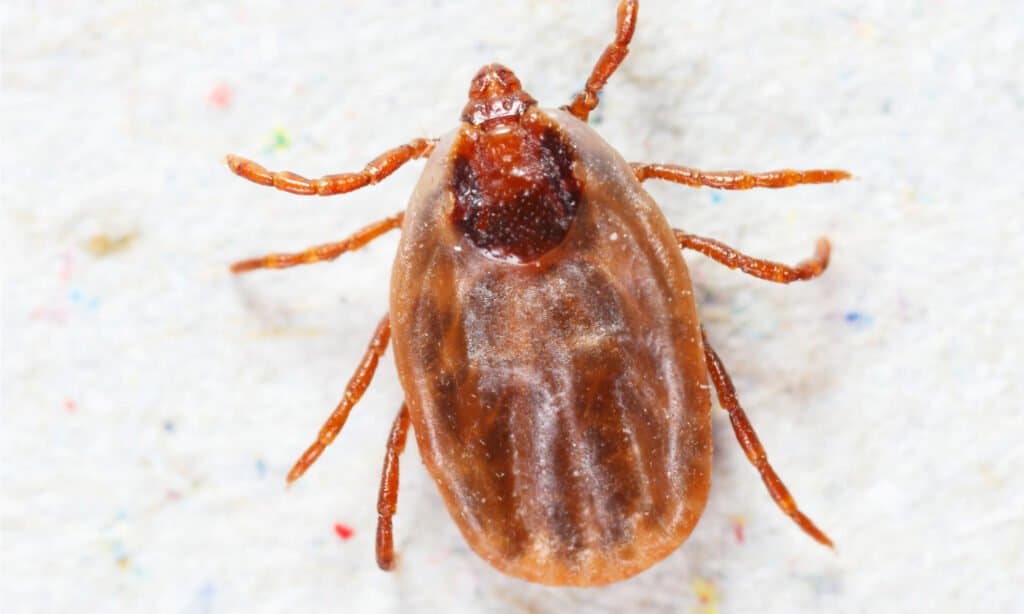
7th Son Studio/Shutterstock.com
Brown dog ticks are one of the most common ticks in Illinois. They live all over the world and feed almost exclusively on canines. Unlike other ticks, who make their homes outdoors, brown dog ticks spend most of their lives inside. They’re most likely to be seen in dog kennels, veterinary offices, or homes with dogs in them.
Brown dog ticks have red-brown, narrow bodies with no markings. They’re vectors of Rocky Mountain spotted fever (when they bite humans) and also several dog-specific diseases.
American Dog Tick (Dermacentor variabilis)
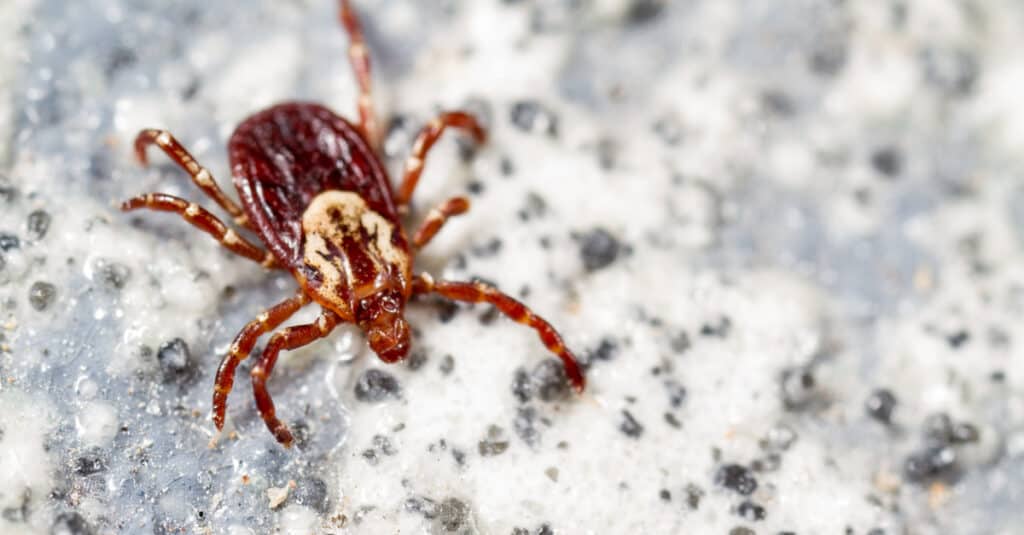
Elliotte Rusty Harold/Shutterstock.com
American dog ticks are closely related to brown dog ticks, though they live in entirely different environs. These ticks in Illinois favor forests over grasslands or human dwellings. They’re the primary vector of Rocky Mountain spotted fever. American dog ticks have dark brown bodies. Females have a white scutum (the shield just behind the head), and males have mottled markings.
American dog ticks are commonly known as wood ticks because they make their homes in the forest. They’re common throughout the eastern United States and along the Pacific coast as far north as Alaska.
When is Tick Season in Illinois?
As with most insects and arachnids, ticks in Illinois are least active in the frigid winter months. Eggs hatch in the spring, and both young ticks and grown adults become most active during the spring and summer. Their activity level decreases significantly during the hottest days of the year and increases again in the fall.
Do Ticks in Illinois have Lyme Disease?

Tomasz Klejdysz/Shutterstock.com
Of all the common ticks in Illinois, only the deer tick carries Lyme disease. Lyme disease is a bacterial infection that affects people in many different ways. Ticks carry the bacteria that causes Lyme disease in their saliva. When an infected tick feeds on a human, it may transfer the bacteria to them. This is why, if you experience a deer tick bite, it’s important to monitor the bite, and your body, for signs that something is not right.
Where do Ticks Live in Illinois?
Unfortunately for Illinois residents, ticks live in most outdoor spaces. They’re common both in the woods and in open grassland. And, thanks to the presence of brown dog ticks, staying inside is no guarantee that you’ll avoid ticks either.
How to Avoid Ticks in Illinois?
If you want to avoid ticks in Illinois, it’s important to do your research and take proper precautions. If you have a dog, be sure to give them flea and tick treatment before any hiking or outdoor activities. For yourself, wear long pants and long-sleeved shirts, and try not to walk in tall grass or thick underbrush. After any outdoor activity, check yourself and your dog for ticks.
More from A-Z Animals
.more-snake-card-image { max-height:140px !important; }
@media (min-width: 481px) {
.mobile-top-content {
display: none;
}
}
#mobileTopContentCTACarouselControls { overflow: hidden; text-overflow: ellipsis; white-space: nowrap; }
.mobile-top-content .more { color: #fff; }
.mobile-top-content a { color: #fff; text-decoration: underline; }
.mobile-top-content a:hover { color: #fff; text-decoration: underline; }
@media (max-width: 480px) {
.mobile-top-content {
background-color: #06a10b;
color: #fff;
text-align: center;
/*height: 60px;
padding-top:5px;*/
font-size:80%;
/* display: block; */
margin: 0px -30px;
}
}
Out of all the tiny creatures that bite us, ticks just may be one of the most reviled. Though they’re not in the same class as mosquitos (mosquitos are insects, whereas ticks are arachnids), tick bites can still turn deadly. There are four common species of ticks in Illinois, but only one of them spreads Lyme disease to humans.
Ticks have been around for over 100 million years, since the Cretaceous era. In all that time, their diet has never changed. Ticks are obligate hematophages, which means they eat nothing but blood. With that blood, they grow, reproduce, and find new hosts.
Here, we’ll learn about the four most common types of ticks in Illinois. Then, we’ll explore when ticks come out in Illinois, where they’re most common, and whether or not they spread Lyme disease. Finally, we’ll go over the steps you can take to avoid tick bites.
Deer Tick (Ixodes scapularis)

Steven Ellingson/Shutterstock.com
Deer ticks live throughout the midwestern and eastern United States and Canada. They start life in the early spring when the eggs hatch and larval ticks emerge. The larval ticks take their first feeding on something small, like a mouse, lizard, or bird. After their first feed, they fall off the host and grow into nymphs. The nymphs feed on another host, then fall off and become adults.
Adult deer ticks are commonly to blame for bites on humans, though white-tailed deer are their preferred prey. Deer ticks live in second-growth forests and boundary zones between forests and grasslands.
Lone Star Tick (Amblyomma americanum)

Maria T Hoffman/Shutterstock.com
Lone star ticks live throughout the eastern United States; they’re one of the more common ticks in Illinois. Females have a single white spot on their back, while males have mottled streaks of white and light brown. They will feed on any available host, including humans and dogs, though they prefer white-tailed deer. These ticks live primarily in wooded areas and thick underbrush.
Lone star ticks were the first tick ever scientifically recorded in America in 1754. They’re aggressive feeders and will even follow carbon dioxide scents in search of prey. These ticks have longer mouthparts than other species of ticks in Illinois, making their bites more likely to cause allergic reactions.
Brown Dog Tick (Rhipicephalus sanguineus)

7th Son Studio/Shutterstock.com
Brown dog ticks are one of the most common ticks in Illinois. They live all over the world and feed almost exclusively on canines. Unlike other ticks, who make their homes outdoors, brown dog ticks spend most of their lives inside. They’re most likely to be seen in dog kennels, veterinary offices, or homes with dogs in them.
Brown dog ticks have red-brown, narrow bodies with no markings. They’re vectors of Rocky Mountain spotted fever (when they bite humans) and also several dog-specific diseases.
American Dog Tick (Dermacentor variabilis)

Elliotte Rusty Harold/Shutterstock.com
American dog ticks are closely related to brown dog ticks, though they live in entirely different environs. These ticks in Illinois favor forests over grasslands or human dwellings. They’re the primary vector of Rocky Mountain spotted fever. American dog ticks have dark brown bodies. Females have a white scutum (the shield just behind the head), and males have mottled markings.
American dog ticks are commonly known as wood ticks because they make their homes in the forest. They’re common throughout the eastern United States and along the Pacific coast as far north as Alaska.
When is Tick Season in Illinois?
As with most insects and arachnids, ticks in Illinois are least active in the frigid winter months. Eggs hatch in the spring, and both young ticks and grown adults become most active during the spring and summer. Their activity level decreases significantly during the hottest days of the year and increases again in the fall.
Do Ticks in Illinois have Lyme Disease?

Tomasz Klejdysz/Shutterstock.com
Of all the common ticks in Illinois, only the deer tick carries Lyme disease. Lyme disease is a bacterial infection that affects people in many different ways. Ticks carry the bacteria that causes Lyme disease in their saliva. When an infected tick feeds on a human, it may transfer the bacteria to them. This is why, if you experience a deer tick bite, it’s important to monitor the bite, and your body, for signs that something is not right.
Where do Ticks Live in Illinois?
Unfortunately for Illinois residents, ticks live in most outdoor spaces. They’re common both in the woods and in open grassland. And, thanks to the presence of brown dog ticks, staying inside is no guarantee that you’ll avoid ticks either.
How to Avoid Ticks in Illinois?
If you want to avoid ticks in Illinois, it’s important to do your research and take proper precautions. If you have a dog, be sure to give them flea and tick treatment before any hiking or outdoor activities. For yourself, wear long pants and long-sleeved shirts, and try not to walk in tall grass or thick underbrush. After any outdoor activity, check yourself and your dog for ticks.

